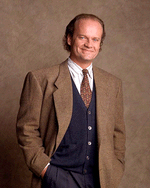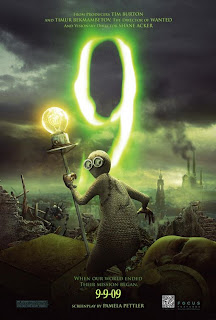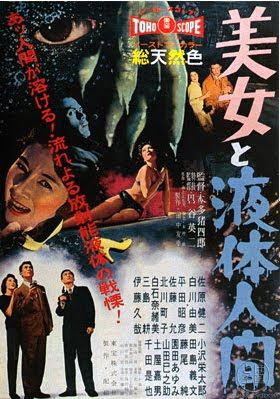
I did not rent ACTIUM MAXIMUS with any expectation that it would be any good at all, and at no point was I surprised on that front. There are already some horrible notices out there, and a few clips on Youtube. It exerted a perverse fascination for me, existing so far outside the boundaries of even low-budget filmmaking; Troma’s well known for releasing deliberately horrible films with lowbrow humor and lower-than-low production values, but this is not that kind of film. Mark Hicks, writer, director, composer, actor, and co-special-effect-er, made ACTIUM MAXIMUS as a labor of love, a pilot for a TV series that could never air anywhere. In its disregard for the basic rules of filmmaking, it takes on the surreal quality of outsider art. Unfortunately, none of this means it’s any good; terminal flaws exist on all levels, like a lasagna made with spoiled cheese, rancid olive oil, and parasite-ridden meat. If that strikes you as an unpleasant image, trust me. You have no idea.
The plot- well, I've worked this out. There’s a space colony called Actium, ruled over by a robot-like dictator known as Polpox (played by Johnathan Daniel McCuin, in some capacity), who rules with an iron- well he doesn’t have fists, or limbs, but he’s harsh. He’s got some genocidal campaign going against a race of limp jellyfish creatures, and distracts the rest of the public from an economy near collapse through the Maximus, which is sort of a gladiatorial festival involving giant alien dinosaur things who look like the scraps left behind when Muppets are made. In charge of acquiring these creatures is Jacinlun Axezun (Hicks himself), a broody attempt at a Han Solo type who is sent off to a distant world to acquire a new breed of monster. In the meantime, numerous assassination attempts are made on the emperor, who complains a lot, and the computers controlling the currency are about to crash because they don’t have enough drives or something, and everyone’s addicted to the heads of some psychic creature, and the dinosaur aliens move around and roar a lot.
Most of this is realized through a mix of puppetry and miniature work, like THE DARK CRYSTAL if it were made by people with no sense of aesthetics. The budget for this was apparently low enough that they couldn’t afford to shoot everything that was in the script, so footage is recycled ad nauseum. A narrator (Butler Yates) makes a game attempt to explain things, while the robots and aliens talk in distorted voices that are sometimes given subtitles and sometimes not, regardless of whether or not we can understand them.
There is live action footage, shot mostly on hilariously non-outer-space-like locations, such as a local zoo, a university promenade, a boiler room, and a swamp right next to a paved road. Puppets and actors are superimposed via blue screen for which the matte boxes were apparently drawn by hand for each frame, and so the outlines of the monsters change shape like they’re characters on DR. KATZ or HOME MOVIES. Titles and subtitles are not offset from the background in any way, and are often illegible. The filmmakers were unable to show the different monster puppets interacting in any way, so the fight sequences consist of shots of them roaring and occasionally chewing on vague viscera. Each puppet and stop motion figure is little more than a piece of latex foam with some paint slapped on, because there was no time in all this to create convincing skin textures or musculature.
What I’m trying to say is, the production values are horrible, ranking somewhere below DOCTOR WHO, SUPERMAN IV, MIGHTY MORPHIN’ POWER RANGERS, the films of Ed Wood, and some of your more ambitious grade school pageants. Normally I don’t pay too much attention to this; the quality of effects can be a crap shoot depending on how much money you have and to whom the work is farmed out, etc. But here, it’s clear evidence that Hicks had no idea that what he had conceived of was too ambitious to realize in any convincing manner, and persevered in the name of doing it “old school”. As much as CGI has been overused in mainstream movies, we should at least have traveling mattes down by now.
More importantly, even if the effects were technically competent, they wouldn’t solve a more fundamental problem: that this movie is ugly as sin. I don’t mean in that striking H. R. Giger sort of way, or the deliberate squalor of modern horror movies, or the texture-riffic experimentation of David Lynch. I mean that it looks like the contents at a dumpster outside a greasy spoon diner after a three month garbage strike. I was not kidding with that spoiled lasagna analogy; everything’s rendered in vomit hues, there are splashes of indistinct gore (that are repeated over and over because there was no shot in this film that was not worth using seventeen times), and a stinky-looking haze pervades every frame in a misguided attempt at atmosphere. Lucio Fulci would get queasy during this movie.
This leads me to my next point, specifically that, through the smog and miasma and indistinct blood, this is one hard movie to follow. The plot is disjointed and throws out a number of ideas that are not developed in any way, shape or form. The jellyfish rebels have a mysterious leader who lives in the ruins of... some place that was here before, and he is never seen. The currency of Actium appears to be large silkscreened portraits of Polpox, or possibly T-shirts. There’s some business about a shortage of Aculipus heads, the space hunter finds an ancient spacecraft, goes inside for a bit, but then goes back searching for the dinosaur monster, and the whole thing ends on a cliffhanger because it’s always good to assume you’ll be able to make a sequel. On some basic level, the filmmakers seem not to understand how scenes and shots work- the repetition of shots has no rhythm, rhyme, or reason, serving only to extend sequences and pad the film. The story itself is full of repetition; at least 70% of it is the Emperor loudly burbling about how his enemies are out to get him and how his currency cannot fail and various combinations of standard “paranoid dictator” business. Even if you figure out what’s going on, it has terrible pacing and no idea of how to build suspense or tension.
Which brings us to the rotten core of this artichoke (yes, I said it was a lasagna before, quiet). If you penetrate the horrible production values, the ugly visual style, and the schizoid storytelling, the concept has one fatal flaw; there is nobody to sympathize with. Polpox is a brutal dictator with no redeeming side, and his rantings and ravings become tiresome in short order. His advisors are toadies. Jacinlun isn’t really actively evil, but he doesn’t do anything to win us over. He travels through space, he complains about things, he theoretically fights monsters. The jellyfish creatures are persecuted minorities, but they are given no personalities. It’s one thing to have morally ambiguous or compellingly scummy characters, it’s another to have No One to Like. The society of Actium is about to go kerplodey and there’s no reason to care.
Do I have anything positive to say about this? Well, the music’s okay, and there’s the barest nub of a good idea buried in all this burbling nonsense. If Mark Hicks had taken on, say, a production designer, an editor (interesting fact- I can find no credit for an editor), a cinematographer, etc... well, it’d still be a story with no likable characters and no structure. The point is, you can’t leap before you can crawl, and you can’t create an ambitious space opera without an understanding of the basics of storytelling, or the understanding that people do not like looking at vomit. ACTIUM MAXIMUS is so astoundingly clueless that it stands as a landmark in bad moviemaking.
That said, I think I like it more than DOWN TO YOU.
Written and Directed by Mark Hicks
Grade: F

 Dr. Frasier Crane (Kelsey Grammer)- First appearing in Boston as part of the show CHEERS, Frasier, a noted psychiatrist, showed up to help Sam Malone combat a relapse into alcoholism, triggered by tensions with on-again/off-again love Diane Chambers. At this point Frasier and Diane were dating (he having met her in a mental institution), and would become engaged, only for her to leave him at the altar for Sam. Whom she would also leave at the altar. Frasier later married Dr. Lilith Sternin, and fathered a son, Frederick. Lilith left Frasier and her son briefly, which was unbearable, and then came back, which was excruciating. Now entering middle age, Frasier is headed back to his home town, Seattle.
Dr. Frasier Crane (Kelsey Grammer)- First appearing in Boston as part of the show CHEERS, Frasier, a noted psychiatrist, showed up to help Sam Malone combat a relapse into alcoholism, triggered by tensions with on-again/off-again love Diane Chambers. At this point Frasier and Diane were dating (he having met her in a mental institution), and would become engaged, only for her to leave him at the altar for Sam. Whom she would also leave at the altar. Frasier later married Dr. Lilith Sternin, and fathered a son, Frederick. Lilith left Frasier and her son briefly, which was unbearable, and then came back, which was excruciating. Now entering middle age, Frasier is headed back to his home town, Seattle. Dr. Niles Crane (David Hyde Pierce)- Frasier's younger brother, also living in Seattle with a successful private practice. The Jungian yin to Frasier's Freudian yang, Niles is married to Maris Crane, heir to a grand 'timber' fortune. They live in a stately mansion with a large staff and several dogs.
Dr. Niles Crane (David Hyde Pierce)- Frasier's younger brother, also living in Seattle with a successful private practice. The Jungian yin to Frasier's Freudian yang, Niles is married to Maris Crane, heir to a grand 'timber' fortune. They live in a stately mansion with a large staff and several dogs..jpg) Martin Crane (John Mahoney)- Frasier and Niles' father, by now-deceased wife Hester Crane. Martin worked as a Seattle police officer for decades, before being shot in the hip during a convenience store robbery. As the series starts, Martin lives in an apartment on his own. Spoilers- this doesn't last.
Martin Crane (John Mahoney)- Frasier and Niles' father, by now-deceased wife Hester Crane. Martin worked as a Seattle police officer for decades, before being shot in the hip during a convenience store robbery. As the series starts, Martin lives in an apartment on his own. Spoilers- this doesn't last.
 Roz Doyle (Peri Gilpin)- A producer at KACL, Seattle's all-talk radio station. (There's also KPXY, the Mighty Pixie, but they don't matter right now.) Roz hails from Wisconsin, and is a fast-rising professional in the radio scene, with aspirations of having her own show. Her primary hobby is men.
Roz Doyle (Peri Gilpin)- A producer at KACL, Seattle's all-talk radio station. (There's also KPXY, the Mighty Pixie, but they don't matter right now.) Roz hails from Wisconsin, and is a fast-rising professional in the radio scene, with aspirations of having her own show. Her primary hobby is men. Eddie (Moose, later Enzo- trained by Matilda de Cagny)- Martin's dog. A currently un-neutered Jack Russell terrier (though they're apparently called Parson Russell terriers now, for some reason.)
Eddie (Moose, later Enzo- trained by Matilda de Cagny)- Martin's dog. A currently un-neutered Jack Russell terrier (though they're apparently called Parson Russell terriers now, for some reason.)



